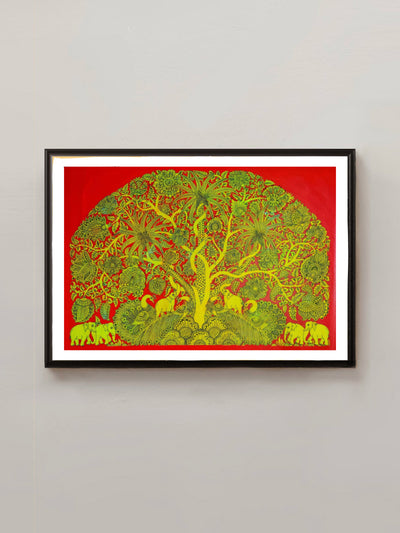Ragamala paintings are the beautiful fusion of art, poetry and music that are inspired by the classical musical modes called ‘ragas. ‘Ragamala’ literally translates as the ‘garland of ragas’ that has the capacity to evoke certain emotions depending on the type of raga represented in a painting. There are mainly six ragas called Bhairavi, Shri, Dipaka, Malkaunsa, Megha and Hindola. The ragas are considered to be in human forms and therefore accompanied by wives (raginis), sons( ragaputras) and daughters( ragaputris).
Each ragamala painting represents a particular season, day and even time of the day depicting a perfect set when a particular raga is sung. Each ragamala painting is depicted in a particular colour evoking a certain mood/emotion in the viewer’s mind which is occasionally accompanied by the poetic text at the top of the painting. The paintings generally represent a love theme that depicts a nayak or nayika in a human form, engaged in a certain activity at a particular time of the day, epitomising the emotion of the raga.

Todi Ragini
This representation of classical music in miniature paintings started around the sixteenth century in Rajasthan from Rajput kingdoms that flourished, reaching as far as Deccan. Every region over time came up with their own styles but in essence, they always depicted the spirit of the ragas. These musical modes, which originated around the fifth century in Indian classical music, inspired many poets to write about their emotive quality in the texts, the
visual representation though, came a little late in history, only about the late fifteenth-early sixteenth century.
Ragamala paintings depict all kinds of emotional states (bhavas). The colours used in the paintings establish and create a surrounding where the play of emotions takes place through the raga. The various human emotional sentiments that were first mentioned in Bharata’s Natyashastra are depicted here. The ragaputras represent the different emotional situations while intense emotions like sorrow, anguish, passion, and joyousness, emerge through the depiction of love.

Raga Hindola
The Bhakti movement that was on the rise during this period also played an important role in the subject depiction of Ragamala paintings. Revolving around the themes of love and divine devotion, the paintings represent ragas and raginis in human form where a nayika is shown pining for her lover, or a couple on the terrace listening to music played by musicians, or a deeper devotion to the deity, for example in Bhairavi Ragini, a nayika is represented worshipping Shiva linga in which she is shown having a tacit conversation with her god, sometimes at night in the outskirts of the city with the moon in the horizon, other times in the mornings with a lush green foliage around the temple.

Bhairavi Ragini
The Ragamala paintings emerged and developed into many different styles like Mughal Ragamala, Pahari Ragamala, and Deccani Ragamala from the sixteenth to nineteenth century. From the late nineteenth century, miniature paintings started losing their patronage as court art due to the onset of British rule and the resultant socio-cultural changes, and with it, Ragamala paintings suffered a decline. The sets of Ragamala paintings that have survived are mostly dispersed, housed in different museums of the world and some are kept in private collections.
- Asia Research News. “Visualising Melodies: The Ragamala Paintings,” June 5, 2023. The Metropolitan Museum of Art. “Ragamala,” May 18, 2022.
- Google Arts & Culture. “Colour Meets Sound - Google Arts & Culture,” n.d
- Heather. “RAGAMALA PAINTINGS FROM INDIA.” Asian Art Newspaper, September 28, 2022.








































0 comments